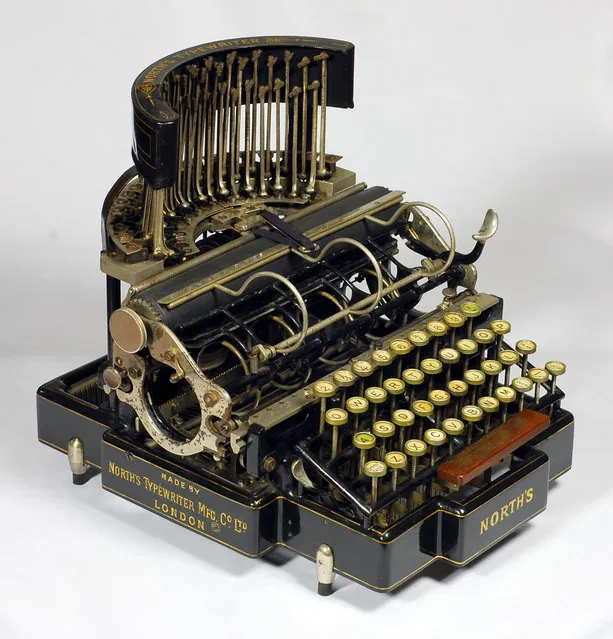
Norths. North's Typewriter Manufacturing Co. Ltd., London, 1892. The North’s typewriter has the rare design feature of having its type-bars stand up vertically behind the carriage. This gives visible typing, with the type bars swinging down to the top of the platen. However this configuration creates a complicated paper-handling situation that requires two “holding baskets” in the carriage, one for the paper to be rolled into before typing and the other for the paper to roll up into as one typed. So visible typing was achieved but only to the extent that a few lines could be seen before the paper advanced into the lower holding basket. The typewriter got its name from Lord North, who bought the factory where the English typewriter had been made in 1890 and financed the development of the North's typewriter which appeared in 1892. (Photo and caption by Martin Howard/Martin Howard Collection)
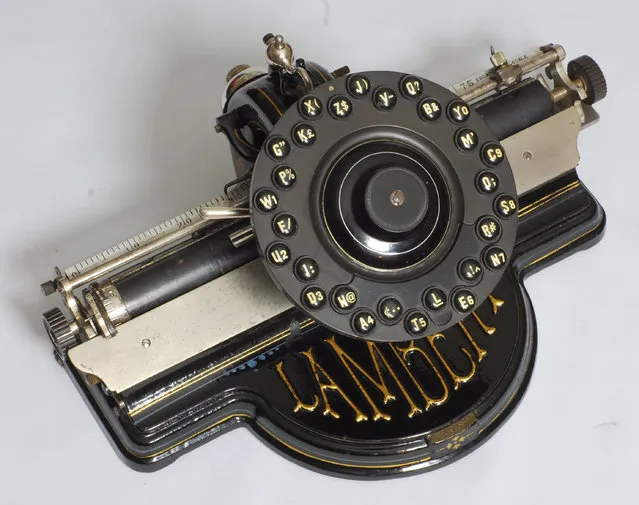
Lambert 1. Lambert Typewriter Co., New York, 1902. The Lambert is a beautiful machine with a most unique design. Frank Lambert, a French immigrant, spent seventeen years developing his typewriter. The first patent was in 1884 and it came to market in 1896. The typewriter sold well in America and Europe for a number of years. One types by pushing down on one of the character buttons, causing the whole round disk to tilt down in that direction. Down below, just above the typing point, is a convex, vulcanite disc (shown below) with all of the characters molded onto it. This surface swings, with the disk above, to the right place for the selected character to be typed; it then descends to make contact with the paper underneath. The middle knob is for spacing. The lever protruding out from the 9:00 position was shifted to three positions, giving three characters for each “key”, for example U, u, and 2. (Photo and caption by Martin Howard/Martin Howard Collection)
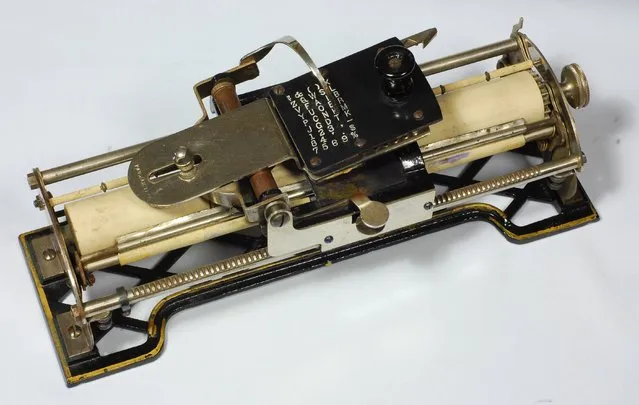
Morris. Hoggson & Pettis, New Haven, Connecticut, 1885. The Morris is about as strange as typewriters got, not the least being a white rubber platen. The advertisement states that the Morris writes 70 words a minute. However, after trying the Morris out, I would be surprised if 12 words could be achieved. Robert Morris of Kansas City invented the Morris typewriter and it was improved upon and manufactured by Hoggson & Pettis, well-established machinists of the day. This typewriter, not surprisingly, did not sell well and today is a rare find. (Photo and caption by Martin Howard/Martin Howard Collection)
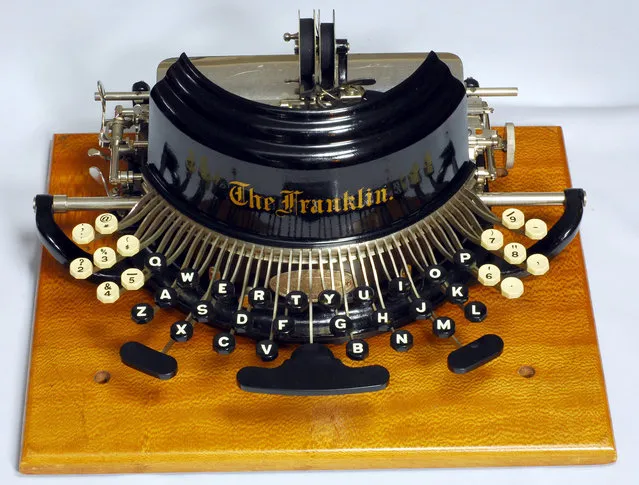
Franklin. Tilton Manufacturing Co. of Boston, 1892. The Franklin is a very beautiful machine with its curved keyboard and curved type-bar shield to match. The type-bars stand up vertically behind the shield and swing down to strike the top of the platen. One can see what is being typed but would need to sit up straight to see over the shield. The Franklin was well built, good to type on, well priced, and attractive. (Photo and caption by Martin Howard/Martin Howard Collection)
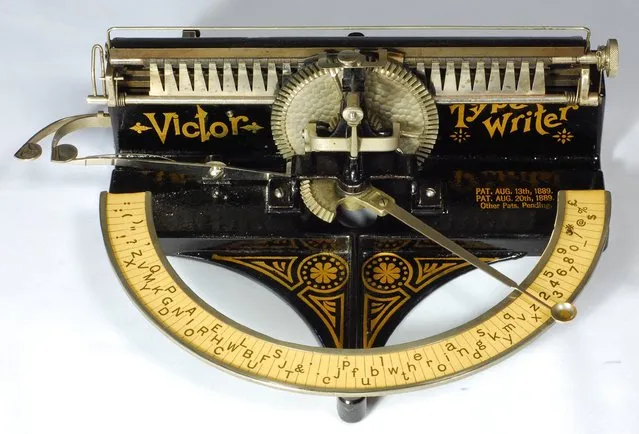
Victor index. Tilton Mfg. Co., Boston, 1889. The Victor is a beautiful Victorian typewriter with handsome decals. This was the first typewriter to use a daisy wheel, which would be a common design feature on 1980s typewriters. The daisy wheel is made of thin brass, cut with narrow radial fingers, one for each character. At the end of each finger is an embossed rubber character. To operate the Victor one puts the tip of ones index finger in the little cup at the end of the pointer, then swings the pointer up to a full 180 degrees to select the characters. The pointer is connected by a gear to the central vertical wheel that holds the daisy wheel. As the pointer swings, the daisy wheel rotates into position. A spring-loaded hammer then pushes the brass finger in the daisy wheel against the paper. This typewriter originally sold for $15.00. (Photo and caption by Martin Howard/Martin Howard Collection)
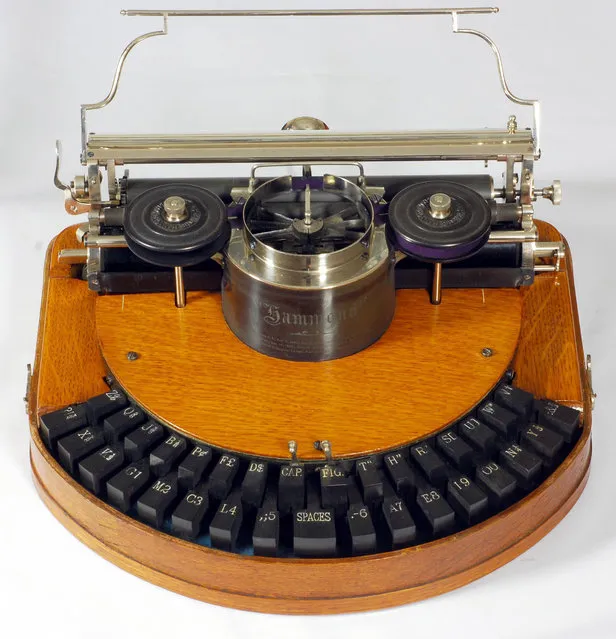
Hammond 1 – Oak. Hammond Typewriter Company, New York, 1885. This striking and gorgeous Hammond 1 is incased in golden oak with solid ebony keys. It is a masterpiece of design and function. The Hammond 1 came in three finishes, oak, cherry, and mahogany. (Photo and caption by Martin Howard/Martin Howard Collection)
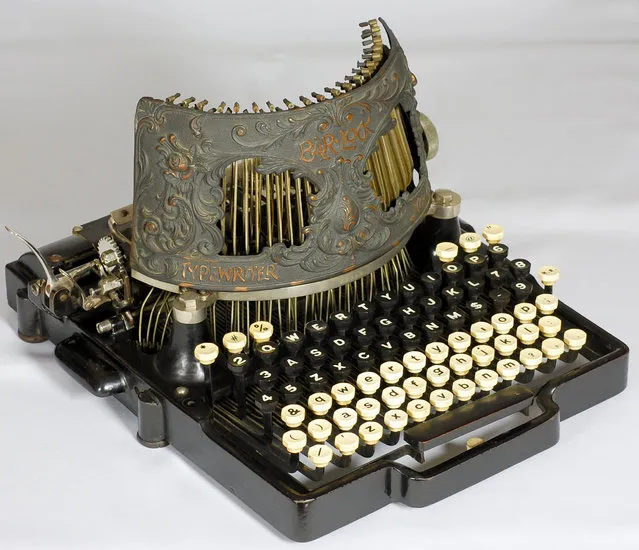
Bar-Lock 4. Columbia Typewriter Co., New York, 1892. Charles Spiro, who apprenticed in his father's New York watchmakers shop, invented the gorgeous Bar-Lock. He had previously invented the Columbia index typewriter. The prominent ornate copper shield covers the type-bars that stand vertically behind. To print, the type-bars swing down to the top of the platen. Just before they strike the platen, the type-bars encounter a small semi-circle of metal pins that ensure alignment. Supposedly these pins also reduce the clashing of the type-bars, but they seem to have little if any effect on either matter. Non-the-less this typewriter gets its name from these alignment pins and their function as a “bar lock” for the type-bars. See detail below. This is a “visible” typewriter, allowing you to see the words as you type them; however, you need to sit up quite straight to see over the curved shield. (Photo and caption by Martin Howard/Martin Howard Collection)
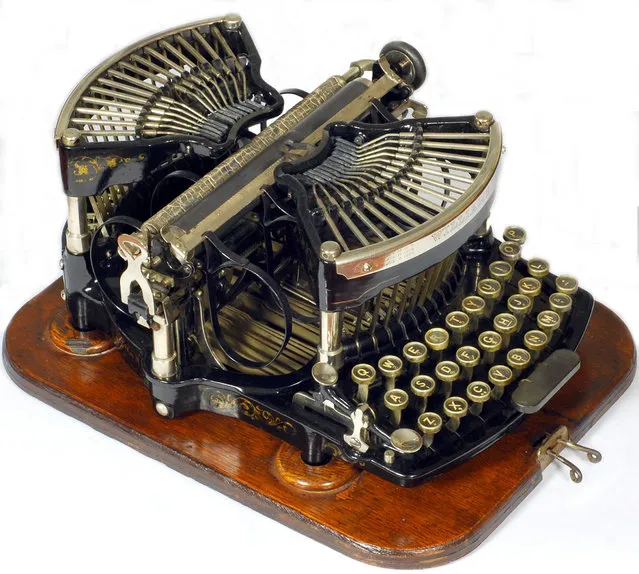
Williams 1. Williams Typewriter Co. Derby, Connecticut, 1891. The most distinguishing aspect of the William's design was the articulated movement of the type-bars as they traveled to the platen. The type-bars are arranged in two fans on either side of the platen and hop-up and over to the top of the platen when typing. The type-bars, resting on ink pads, were inked when they came back to their starting position. With no ribbon to get between the type-bars and the paper, the printing was very sharp. This typewriter proudly offered visible writing, but only one line at a time, as the paper would disappear into a cylinder, as the paper was advanced. The Williams typewriter had a wonderful responsive touch to the keys and was a great machine to type on. It had considerable success with a model 6 being produced before the company went out of business in 1909. This typewriter originally sold for $95.00. (Photo and caption by Martin Howard/Martin Howard Collection)
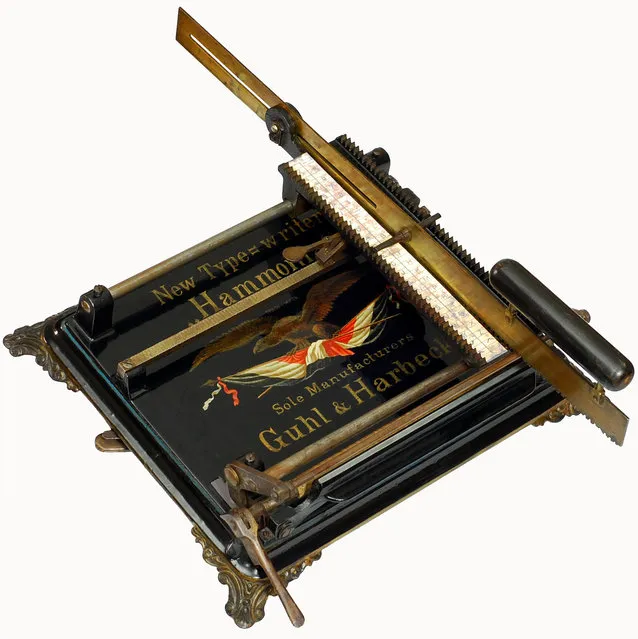
Hammonia. Guhl & Harbeck, Hamburg, Germany, 1884. The Hammonia was the first European typewriter to be produced in any numbers; however, this machine is scarce today. It was invented by Andrew Hanson of London and covered by a British patent in 1882. The long brass blade has the characters cut out along the bottom edge (see photo detail below). To type one lifts the blade and moves it back and forth to select a character, then one pushes the black wooden handle straight down somewhat like a cheese slicer! Hammonia is the name of the patron goddess of Hamburg (where the typewriter was made), who first appeared in art and literature in the 18th century. (Photo and caption by Martin Howard/Martin Howard Collection)
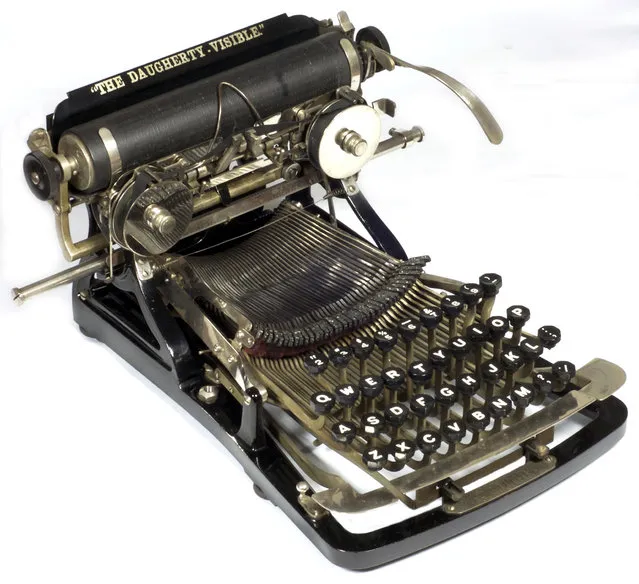
Daugherty. The Daugherty Typewriter Co., Pittsburgh, Pennsylvania, 1893. This elegant typewriter pioneered the ubiquitous, 4-row, front-strike, see-as-you-type design, however it would be the Underwood typewriter that would steal the show soon after in 1896 by having the same optimum design features as the Daugherty but in a far better functioning machine. The “modern” typewriter had arrived and the early age of invention for the typewriter was nearly over. (Photo and caption by Martin Howard/Martin Howard Collection)
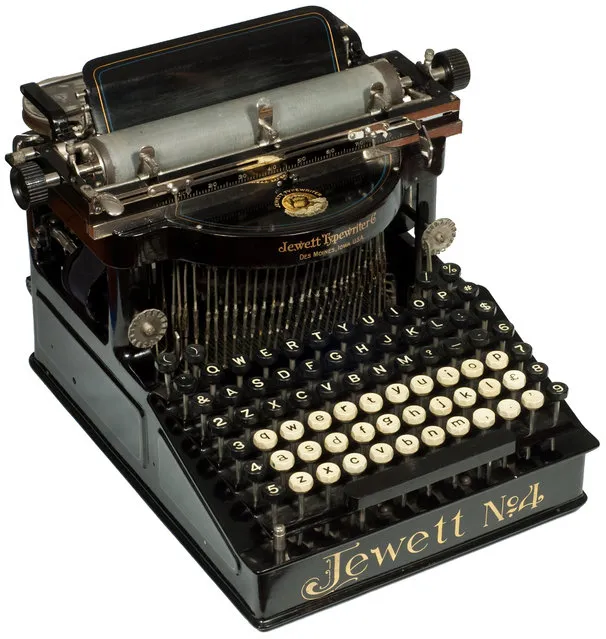
Jewett 4. Jewett Typewriter Company, Des Mones, Iowa, 1897. This beautiful typewriter is made with the up-most quality and in fact, as the logo states, “The best in the world”, my not be far from the truth! (Photo and caption by Martin Howard/Martin Howard Collection)
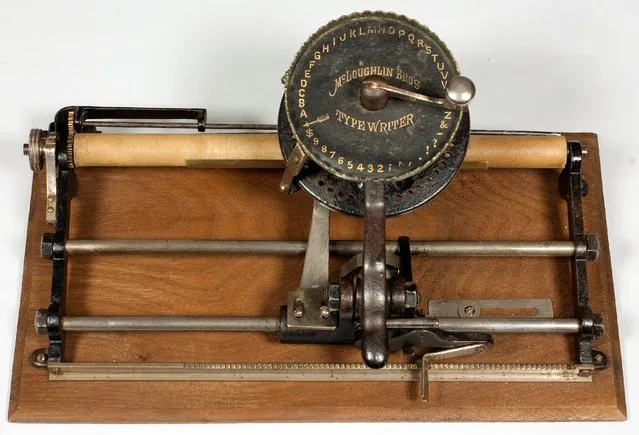
McLoughlin. McLoughlin Bros. Inc, New York, 1884. Little information is known about the McLoughlin Brothers Typewriter. It appeared on the market in 1884 for $10 and was intended for both children and adults. Therefore the McLoughlin Brothers typewriter has the distinction of being the first typewriter marketed for children; however, it is built solidly from cast iron and machined parts making it a contemporary to the few other adult index typewriters that had appeared by this early date for manufactured typewriters. To type, the handle is rotated to select a character. Then the handle is depressed, causing the whole spring loaded carriage assembly to sink down, bringing the type-wheel (shown below) into contact with the paper. Inking is accomplished with two felt rollers. (Photo and caption by Martin Howard/Martin Howard Collection)
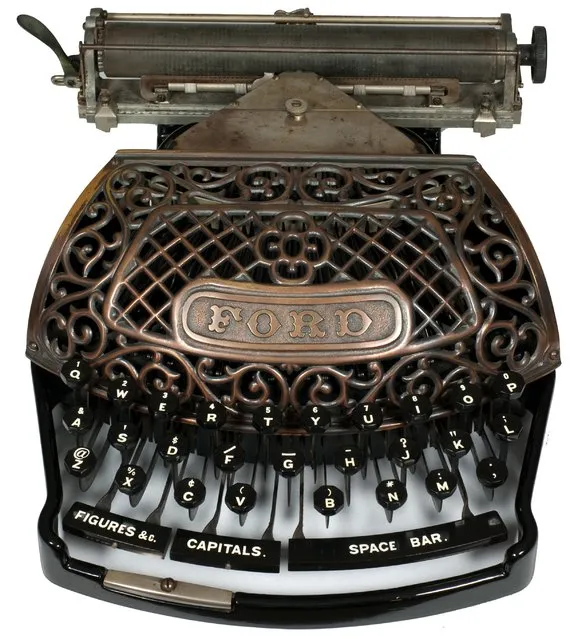
Ford. Ford Typewriter Company, New York, 1895. The Ford typewriter is a striking machine with its beautiful ornate grill and gracefully integrated keyboard. It was a machine to grace the eyes but would not have endeared itself to the typist, as the keys are rather springy and wobbly when typing and the platen surprisingly does not have a line-by-line clicking action. Also the shift keys for capitals and figures require a solid push to operate, not a good design for fast typing. However, what the Ford did have was visible writing, allowing one to see the typed words on the platen as soon as they were typed. It was not the first to do this but most contemporary typewriters were still blind writers, requiring one to lift the carriage to see the last few typed lines. The Ford typewriter broke new ground in being the first typewriter to use the new metal “aluminum” in its construction. The Ford was sold in two versions, one with an all aluminum frame and carriage and the other with a cast iron, black enameled, frame and aluminum carriage, as shown above. Both sport a beautiful Japanned grill. (Photo and caption by Martin Howard/Martin Howard Collection)
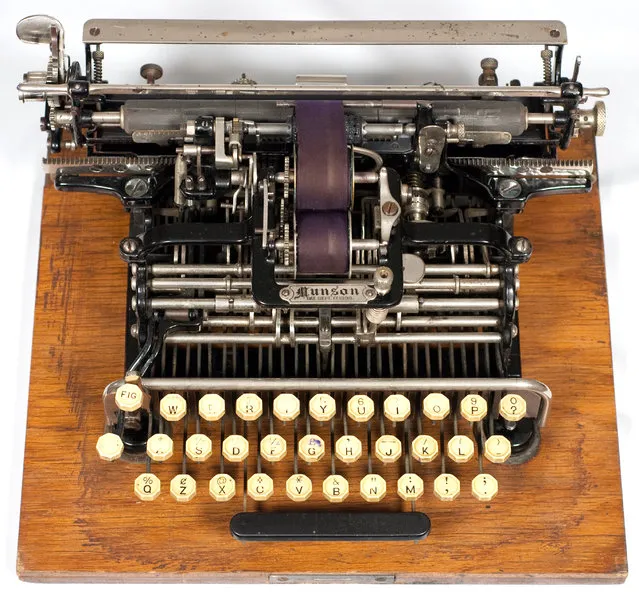
Munson 1. Munson Typewriter Manufacturing Co., Chicago, 1890. The Munson typewriter is a remarkable piece of engineering, with a complex and original mechanical design packed into a small frame. Its inner workings are largely exposed, so the machine comes to life with moving rods and levers when being used. The Munson does not have type-bars but uses a horizontal type-cylinder (about the size of ones finger) that slides from side-to-side and rotates to have the correct character move into place. Then a hammer strikes the paper from behind, pushing the paper against the ribbon and type-cylinder. Type-cylinders with different fonts were available. With two shift keys, uppercase and figures, only three rows of keys are required. (Photo and caption by Martin Howard/Martin Howard Collection)
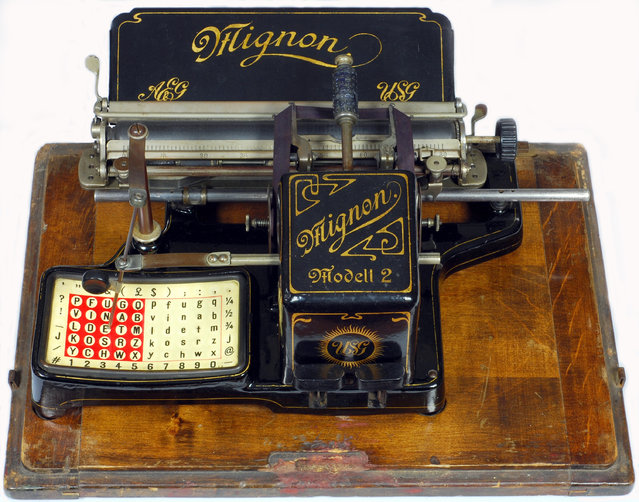
Mignon 2. A.E.G., Berlin, Germany, 1905. Despite its unusual appearance, the Mignon typewriter is of a very clever design, giving a smooth and fast operation for typing. With thumb and forefinger, one pinches the black tab on the pendulum. The pendulum swings freely over the index plate and is moved to point at the desired character. Then the black button at the front of the machine (one is for spacing) is pushed down, causing the type-cylinder to come down onto the top of the platen. The index plate and the type-cylinder could be changed, allowing for different languages and fonts. The Mignon was popular for three decades and was still produced into the early thirties. (Photo and caption by Martin Howard/Martin Howard Collection)
25 Sep 2013 08:37:00,
post received
0 comments
